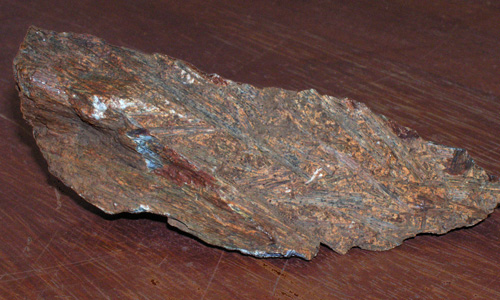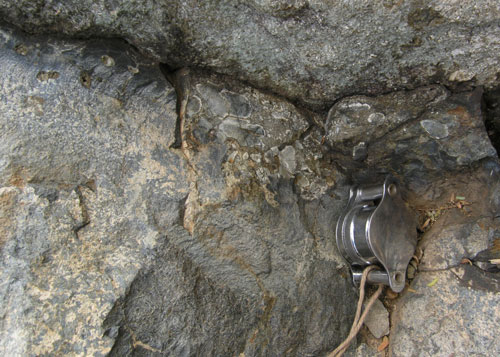The theme for the latest edition of The Accretionary Wedge is ‘my pet rock’. Unfortunately, most of the ‘deskcrops’ that I’ve amassed over the years are back in storage in the UK, but since arriving here in South Africa I have managed to pick up a couple of interesting replacements. I’ve been meaning to discuss this one for a while: even though it’s not the prettiest in my collection, it tells a very interesting story about the early Earth.

The most striking thing about this rock is the texture. It’s stuffed full of radiating bundles of long, thin olivine crystals:

This is known as a ‘spinifex texture’ after an Australian grass with an allegedly similar morphology – and a reputation for slicing unwary field geologists’ legs into ribbons.
Olivine is a mineral found in mafic volcanic rocks like basalts, and the rocks that I retrieved this sample from, part of the Archean Barberton greenstone belt, are quite clearly lava flows, as shown by features such as this brecciated upper surface:

Large crystals – phenocrysts – in a lava generally represent a phase which slowly crystallised from the magma while it was still underground, but such long, thin, delicate crystals seem unlikely candidates to survive the rough and tumble of a volcanic eruption intact. Furthermore, at some exposures of this formation you can quite clearly see that the crystals have formed in place: within individual lava flows, you can clearly see the largest crystals restricted to, and apparently growing from, the base of the flow, where the lava cools slowest. Smaller olivine needles are found closer to the top, and in the upper part, which would have cooled the fastest, the lavas are entirely fine-grained.

The trend of decreasing grain size towards the edge of a flow is quite a common phenomenon, but even in the more slowly cooling interior, you wouldn’t expect to see such large olivine crystals. The key to solving this mystery lies in the composition of these rocks: they are ultramafic – much more highly enriched in magnesium than any lavas found erupting on the Earth’s surface today. Such ultramafic lavas are known as komatiites, after the Komati River which runs through the area I collected my deskcrop from.
Ultramafic lavas are close to the composition of the mantle from which they were originally derived. This implies that all of the mineral phases in melting mantle rocks contributed equally to the magma, rather than it being dominated by the minerals with slightly lower melting temperatures (which is what causes basalts have a different, less olivine rich, composition). This implies melting at temperatures several hundred degrees hotter than is usual on the Earth today.
The resulting Archean lavas would also have been very hot, and would thus have had a very low viscosity (they would behave more like water, and less like honey or golden syrup). Within the interior of a flow, this would have made the crystallisation of minerals out of the lava very difficult; the few crystals that did nucleate were therefore able to grow to very large sizes, because they would not have to compete for space or elements with adjacent growing crystals. And because the base of the lava flow would provide a good early source of nucleation points for crystal growth, crystals would tend to grow upwards from it, as can be seen in the cross-sectional view above. Voila: spinifex.
Komatiites, and the spinifex textures that you find within them, are almost exclusively restricted to rocks of Archean age or older. They are a window into the internal state of the Earth 3 or 4 billion years ago, and indicate that the temperature of the mantle was as high as 1600 Celsius, compared to about 1200 C today. This is not unexpected: just like Mars, the Earth has been losing heat since it formed, albeit more slowly. What is still not certain is what effect this additional heat, and the more rapid mantle convection that it implies, would have had on plate tectonics: did it cause things to happen at different rates and length scales? Or were entirely different processes shaping the Earth’s surface? That’s something that I’m hopefully going to shed a bit of light on with my own research.



Comments (4)